What Steps to Take for Multi-Cat Household Harmony
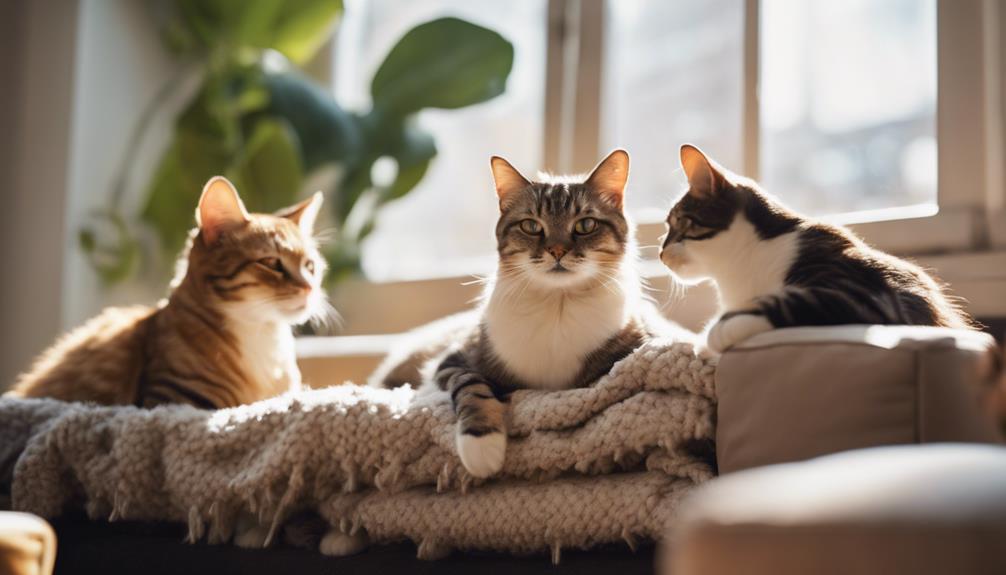
- Establish a safe space for each cat where they can eat, sleep, and use the litter box without being disturbed by other cats.
- Provide multiple litter boxes to prevent territorial disputes and ensure that each cat has access to a clean and private area.
- Offer plenty of vertical space, such as cat trees and shelves, for cats to climb and perch on to escape conflicts or simply relax.
- Create separate feeding stations to prevent resource guarding and allow each cat to eat in peace.
- Provide toys and interactive play sessions to help cats release energy and reduce stress, which can prevent aggressive behaviors.
- Regularly groom and pet each cat to prevent social tension and reinforce positive relationships between them.
- Monitor the cats' interactions and intervene if you notice any signs of aggression or tension, such as hissing, growling, or swatting.
- Consider using pheromone diffusers or calming collars to help reduce stress and promote a peaceful environment for all cats in the household.
Ensure that each cat receives individual attention and care to prevent feelings of competition and jealousy among them. Building a harmonious multi-cat household requires patience, understanding, and a proactive approach to address any potential conflicts before they escalate.
Understanding Cat Behavior
To ensure harmony in a multi-cat household, it's crucial to understand the unique behaviors and instincts of each feline resident. Feline communication plays a vital role in establishing social hierarchy among cats living together. Paying attention to how cats interact through body language, vocalizations, and scent marking can provide insights into their relationships and dynamics within the group. Recognizing stress signals, such as excessive grooming, hiding, or aggression, is key to addressing any underlying issues that may disrupt the peace in the household.
Bonding behaviors, such as mutual grooming, playing together, or sharing resting spaces, help strengthen the relationships between cats and promote a sense of unity. Encouraging positive interactions and providing opportunities for cats to engage in activities together can foster a sense of companionship and reduce potential conflicts. By observing and understanding feline communication, social hierarchy, stress signals, and bonding behaviors, caregivers can create a conducive environment where all cats feel secure and valued in the multi-cat household.
Providing Separate Resources
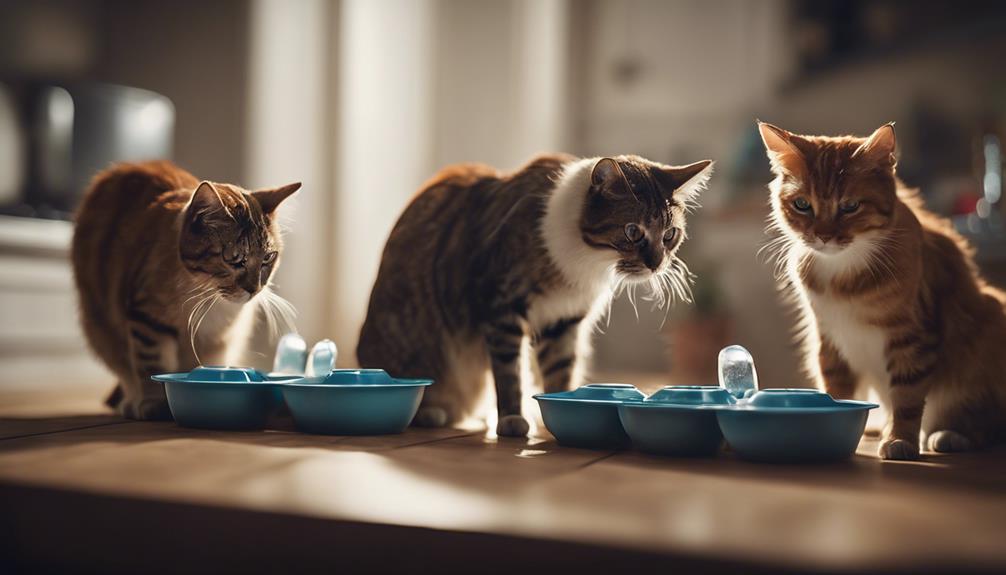
In multi-cat households, it's crucial to provide separate resources to ensure each feline feels secure and content. Setting up individual feeding stations and having multiple litter box locations can help prevent competition and reduce stress among cats.
Individual Feeding Stations
Ensuring each cat has its designated feeding station can significantly reduce mealtime conflicts in a multi-cat household. Cats can be territorial about their food, leading to stress and tension during feeding times. To promote harmony, consider the following:
- Establish Individual Feeding Stations: Assign separate areas for each cat to eat peacefully.
- Maintain a Consistent Feeding Routine: Stick to a regular schedule to help cats feel secure and minimize competition.
- Utilize Behavior Training: Encourage positive behaviors during mealtime through reinforcements like treats or praise.
Multiple Litter Box Locations
For a harmonious cohabitation among multiple cats, it's essential to provide separate litter box locations to ensure each cat has its own designated space for elimination.
When considering litter box placement, space considerations are crucial. Cats value their privacy, so having multiple litter boxes in different areas of the house can prevent territorial disputes. It's recommended to have one litter box per cat plus one extra to avoid overcrowding.
Additionally, litter box maintenance is key to odor control. Regular scooping and changing of litter are necessary to keep the area clean and inviting for your feline friends.
Establishing Territory and Safe Zones
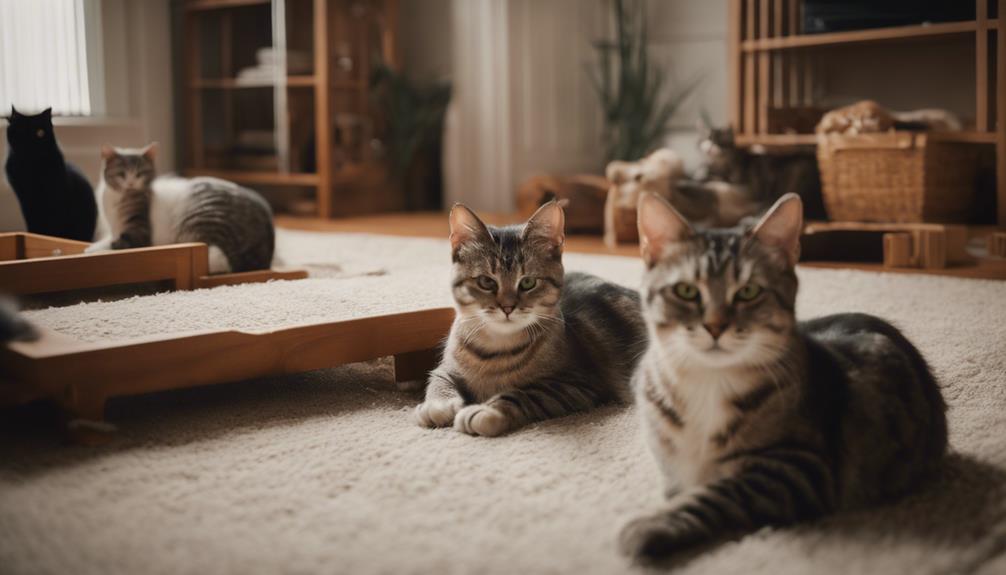
Establishing a sense of ownership over specific areas can help cats feel more secure and reduce conflicts in a multi-cat household. Cats are territorial animals by nature, and having clearly defined spaces can promote harmony among them.
- Designated Areas: Assign specific areas for each cat within the house, such as separate sleeping spots or feeding stations.
- Vertical Territory: Utilize vertical spaces like cat trees or shelves to create more territory for each cat.
- Safe Havens: Provide hiding spots or elevated perches where cats can retreat to if they feel overwhelmed.
Implementing Scheduled Playtime
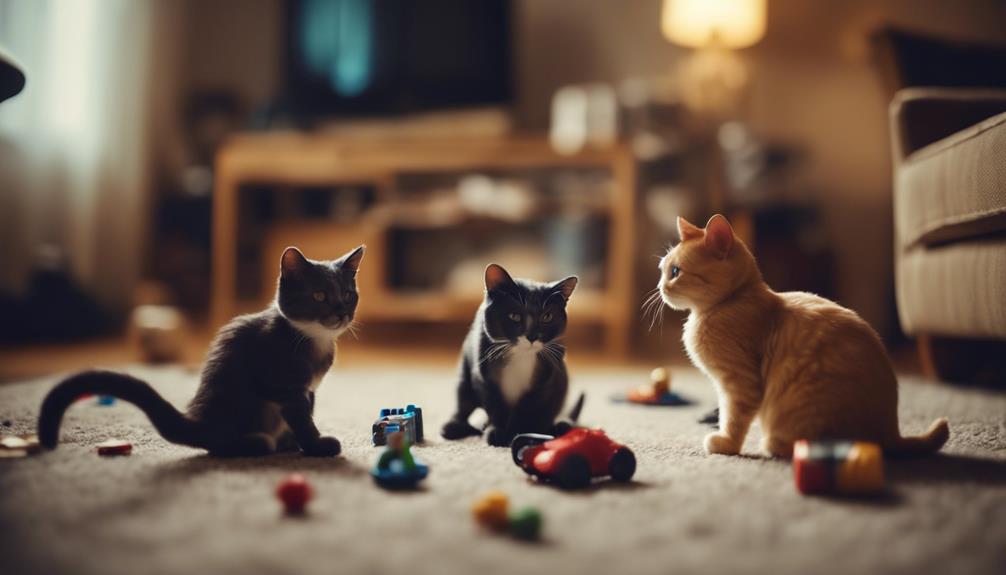
To ensure harmony in a multi-cat household, implementing scheduled playtime is crucial. Regular play sessions not only provide exercise but also help in reducing tension and preventing behavioral issues.
Selecting interactive toys and rotating play areas can keep the cats engaged and content.
Playtime Frequency Importance
Implementing scheduled playtime can significantly enhance the harmony in a multi-cat household by providing structured opportunities for each cat to release excess energy and bond with their feline companions. Establishing a consistent playtime routine fosters a sense of predictability and security for the cats, reducing stress and potential conflicts. It also encourages socialization among the cats, helping them build stronger relationships and minimizing territorial behaviors.
To ensure effective playtime sessions, consider rotating socialization techniques such as group play, interactive activities, and individual attention. By investing time in playtime frequency and variety, cat owners can create a more peaceful and enjoyable environment for their feline friends.
- Establish a consistent playtime routine
- Encourage socialization through group play
- Rotate interactive activities for variety
Interactive Toy Selection
When selecting interactive toys for scheduled playtime in a multi-cat household, consider the preferences and activity levels of each feline companion. Toy engagement levels play a crucial role in keeping your cats entertained and active.
Opt for toys that offer different levels of interaction, such as puzzle feeders, feather wands, or laser pointers, to cater to varying interests. Introducing a variety of toys will help prevent boredom and ensure that each cat has something they enjoy during playtime.
Rotating the toys regularly can also maintain their novelty and keep the cats engaged. By understanding your pets' individual preferences and incorporating diverse interactive toys, you can create a stimulating play environment that promotes harmony among your furry friends.
Rotating Play Areas
Consider designating different areas in your home for scheduled playtime to keep your multi-cat household engaged and entertained. By implementing a playtime rotation with designated areas, you can create a stimulating environment for your feline companions. This strategy helps prevent boredom and encourages physical activity and mental stimulation.
To make the most out of rotating play areas, you could:
- Rotate Toys: Switch up the toys available in each designated play area regularly to keep your cats interested.
- Engage in Interactive Play: Participate in engaging activities with your cats in these designated areas to strengthen your bond and provide mental enrichment.
- Create Climbing Spaces: Incorporate vertical spaces like cat trees or shelves in different play areas to encourage exercise and exploration.
Ensuring Litter Box Accessibility
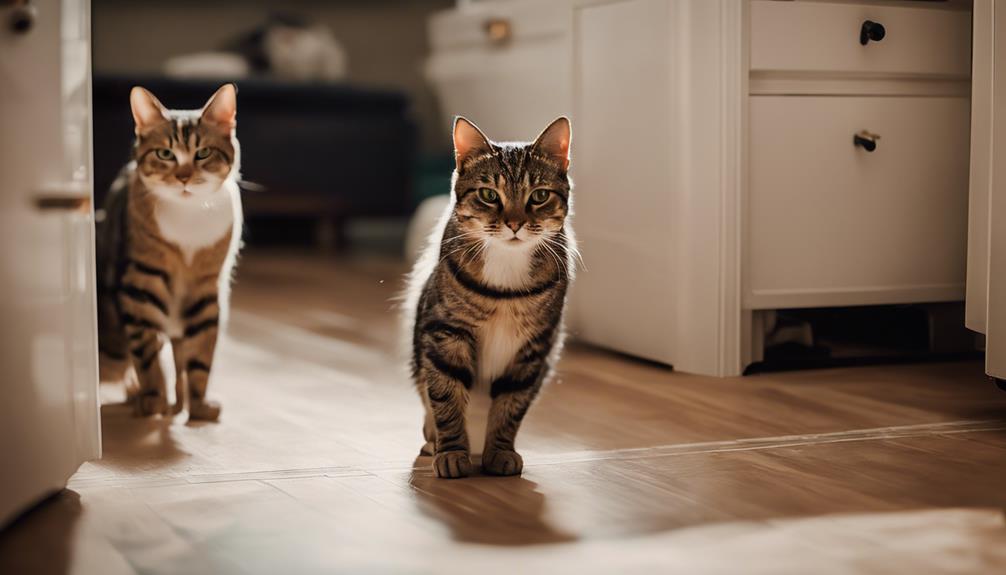
To ensure all cats in a multi-cat household have easy access to their litter boxes, it is crucial to strategically place them in separate but accessible locations throughout the home. Cats are territorial animals, and having multiple litter boxes helps prevent conflicts over territory establishment. Placing litter boxes in various areas can also reduce the chances of one dominant cat preventing others from using the boxes. Here are some tips to ensure litter box accessibility:
| Location | Tips |
|---|---|
| Different Rooms | Spread litter boxes in different rooms to provide options and prevent overcrowding. |
| Quiet Spaces | Place litter boxes in quiet areas away from loud noises or high-traffic spots for privacy. |
| Easy Access | Ensure that litter boxes are easily reachable, especially for older or less mobile cats. |
| Regular Cleaning | Maintain a consistent cleaning schedule to keep the litter boxes appealing and hygienic. |
Creating Vertical Spaces
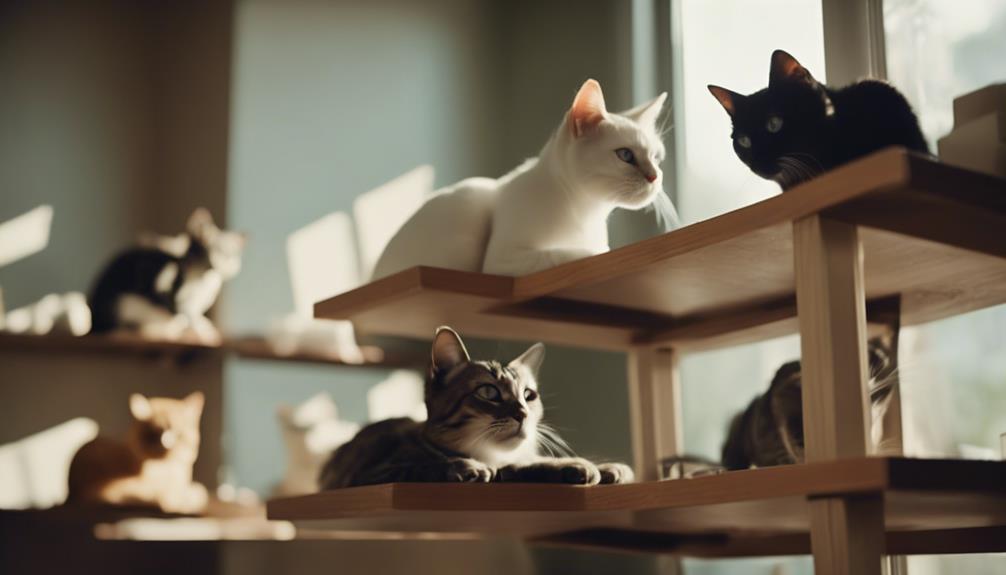
To enhance the living environment for multi-cat households, incorporating vertical spaces is essential for providing cats with opportunities to climb, perch, and observe their surroundings. Vertical spaces cater to a cat's natural instincts, allowing them to feel safe, secure, and in control of their environment.
Here are some practical ways to create vertical spaces for your feline friends:
- Cat shelves: Installing cat shelves at different heights gives your cats designated areas to climb and relax.
- Scratching posts: Incorporating scratching posts into your vertical spaces not only provides a climbing surface but also helps in maintaining your cats' claws.
- Climbing structures, perches: Investing in climbing structures and perches can offer your cats various levels to explore and rest comfortably.
Monitoring Interactions and Body Language
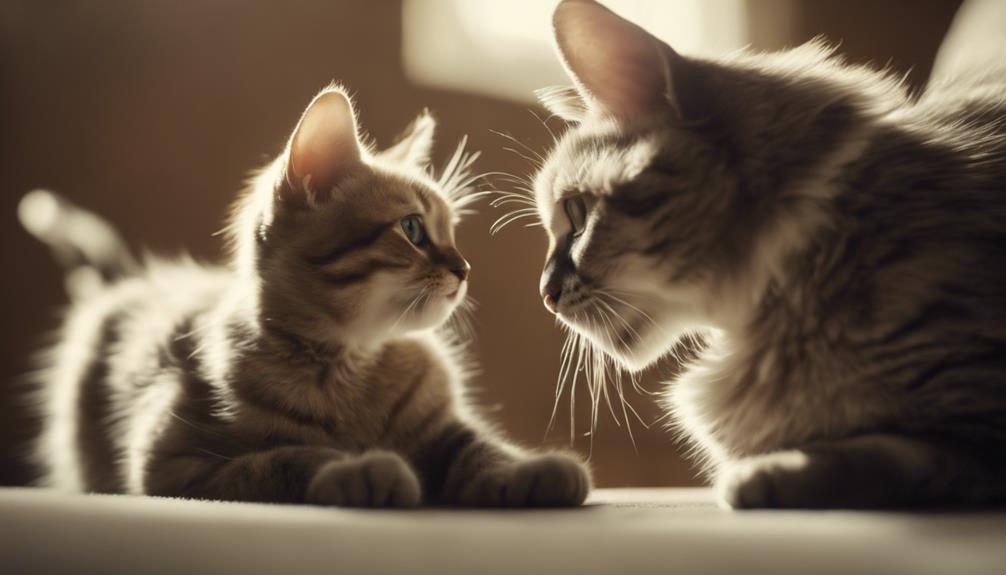
Regularly observing your cats' interactions and body language is crucial for maintaining harmony in a multi-cat household. By paying attention to body language cues and understanding the dynamics of their interactions, you can better assess their behavior and social dynamics. Cats communicate through their body language, such as flattened ears, raised fur, or tail flicking, which can indicate stress, aggression, or playfulness. Monitoring these cues allows you to intervene when necessary and prevent conflicts from escalating.
Behavior monitoring is essential in multi-cat households to ensure that each feline feels safe and comfortable. Keep an eye on how they interact during feeding times, play sessions, or when sharing resting spaces. Understanding their social dynamics can help you identify if one cat is being bullied, feels threatened, or is overly dominant. By observing and addressing these behaviors early on, you can promote a more harmonious environment for all your cats to thrive. Remember, your attentiveness plays a significant role in fostering a peaceful coexistence among your furry companions.
Frequently Asked Questions
How Can I Tell if My Cats Are Playing or Fighting?
Cats often display subtle differences between playing and fighting. Body language and vocal cues are key indicators. Play behavior involves relaxed postures and gentle movements, whereas aggression shows tense body language, growling, hissing, and swatting.
What Should I Do if One of My Cats Is Constantly Marking Their Territory?
If one cat is constantly marking territory, behavioral training and deterrents can help. A medical evaluation may be needed to rule out health issues. Behavior modification techniques can address this. Consistency and patience are key.
Are There Any Specific Toys or Activities That Are Best for Multi-Cat Households?
In multi-cat households, providing enrichment activities like puzzle feeders and interactive toys can keep cats engaged and reduce tension. Bonding exercises, such as group play sessions or communal grooming time, foster socialization and harmony.
How Do I Introduce a New Cat Into My Existing Multi-Cat Household?
When introducing a new cat into a multi-cat household, gradual integration is key. Start by keeping the new cat in a separate room to allow for scent swapping and gradual supervised introductions to monitor behavior and ensure a smooth socialization process.
How Can I Prevent Jealousy and Competition Among My Cats?
Preventing jealousy and competition among cats is key for harmonious living. Understanding feline behavior helps in handling these emotions. Establishing clear hierarchy and boundaries, providing individual attention, and creating separate spaces can reduce conflicts and promote peaceful coexistence.











